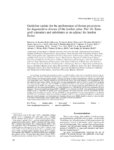Filters: School Or College: "School of Medicine" Department: "Neurosurgery" Collection: "ir_uspace" Format: "application/pdf"
| Creator | Title | Description | Subject | Date | ||
|---|---|---|---|---|---|---|
| 176 |
 |
Dailey, Andrew T. | Paragangliomas of the sellar region: report of two cases | TWO CASES OF paraganglioma arising from the parasellar region are presented. Both occurred in middle-aged women who sought treatment of headaches but who had no endocrinological dysfunction; one case was associated with ophthalmoplegia from cavernous sinus involvement. Diagnosis in both cases was ... | Paragangliomas; Sellar region; Parasellar region; Chemodectoma; Pituitary tumor | 1993 |
| 177 |
 |
Couldwell, William T. | Use of the h index in neurosurgery | Object. Assessing academic productivity through simple quantification may overlook key information, and the use of statistical enumeration of academic output is growing. The h index, which incorporates both the total number of publications and the citations of those publications, has been recently ... | 2009-01-01 | |
| 178 |
 |
Couldwell, William T. | Malignant glioma-derived soluble factors regulate proliferation of normal adult human astrocytes | Malignant gliomas are characteristically surrounded by marked gliosis. To assess whether glioma-derived products contribute to the proliferation of astrocytes, a feature of the gliosis response, we evaluated the influence of culture supernatants from malignant human glioma lines and tumor cyst fluid... | Astrocyte; Glioma; Gliosis; Proliferation; Soluble factors | 1992 |
| 179 |
 |
Couldwell, William T. | Strategies for the management of nonsecreting pituitary adenomas | The two objectives of treating pituitary tumors are: (1) relief of signs and symptoms attributable to mass effect, and (2) correction of hypo - or hypersecretion of adenohypophyseal hormones.7 When nonsecreting tumors are specifically considered, correction of endocrine abnormalities may be of les... | Pituitary adenomas; Transsphenoidal surgery | 1991 |
| 180 |
 |
Kestle, John R. W. | Cost-effectiveness analysis of endoscopic third ventriculostomy | OBJECTIVE: Endoscopic third ventriculostomy (ETV) is currently the principal alternative to cerebrospinal fluid shunt placement in the management of pediatric hydrocephalus. Cost-effectiveness analysis can help determine the optimal strategy for integrating these different approaches. METHODS: All... | Endoscopic third ventriculostomy; ETV | 2002 |
| 181 |
 |
Dailey, Andrew T. | Resolution of an actinomycotic abscess with nonsurgical treatment: case report | A CASE OF actinomycotic brain abscess is presented. Conservative treatment by prolonged administration of antibiotics after needle biopsy showed complete resolution of the abscess. Previously reported cases suggest that definitive treatment requires excision or open surgical drainage of the abscess... | Actinomycotic abscess; Brain abscess; Actinomyces israelii; Nonsurgical treatment | 1993 |
| 182 |
 |
Couldwell, William T.; Schmidt, Richard H.; Salzman, Karen L.; Chin, Steven S. | Glioblastoma multiforme of the pineal region | Glioblastoma multiforme (GBMs) tumors are exceedingly rare tumors in the pineal region. We present three cases in which patients presented with a pineal/posterior third ventricular region mass and review all the previously reported cases in the literature. Pineal region GBM seems to be a very aggre... | Glioblastoma multiforme; Hydrocephalus; Leptomeningeal dissemination; Malignant glioma; Perinaud's syndrome; Pineal region; Spinal metastases | 2006 |
| 183 |
 |
Couldwell, William T. | Inflammatory pseudotumor of the cavernous sinus and skull base | Inflammatory pseudotumor is a non-neoplastic process of unknown etiology characterized by a proliferation of connective tissue with an inflammatory infiltrate. Intracranial inflammatory pseudotumors classically involve the cavernous sinus but can also occur in the supratentorial or infratentorial c... | Intracranial neoplasm; Pseudotumor; Skull base | 2006 |
| 184 |
 |
Couldwell, William T.; Orlandi, Richard R.; Jensen, Randy L. | Endoscopic-assisted craniofacial resection of esthesioneuroblastoma: minimizing facial incisions | The surgical management of esthesioneuroblastomas has traditionally been craniofacial resection, which combines a bifrontal craniotomy with a transfacial approach. The latter usually involves a disfiguring facial incision, mid-facial degloving, lateral rhinotomy, and/or extensive facial osteotomies... | Esthesioneuroblastoma; Craniofacial resection; Endoscope; Craniofacial surgery; Minimally invasive | 2003 |
| 185 |
 |
Couldwell, William T. | Immunology and immunotherapy of intrinsic glial tumors | Immunological aspects of glial neoplasms have been actively investigated for the past several years with particular focus on academic, diagnostic, and therapeutic objectives. As more knowledge is acquired about the cellular events relating to tumor behavior the more it appears that the immune system... | Immunology; Glial tumors | 1990 |
| 186 |
 |
Schmidt, Meic H. | Role of light-emitting diodes for photodynamic therapy of brain tumors | The development of more effective light sources for Photodynamic Therapy (PDT) of brain tumors would be of benefit for both research and clinical application. In this study, the use of light-emitting diode arrays for PDT of brain tumors with Photofrin® porfimer sodium was investigated. An inflatabl... | Aluminum Gallium Arsenide; Photodynamic therapy; Brain tumors; Photofrin | 1996 |
| 187 |
 |
Kestle, John R. W. | Lack of benefit of endoscopic ventriculoperitoneal shunt insertion: a multicenter randomized trial | Object. Endoscopically assisted ventricular catheter placement has been reported to reduce shunt failure in uncontrolled series. The authors investigated the efficacy of this procedure in a prospective multicenter randomized trial. Methods. Children younger than 18 years old who were scheduled for t... | Ventriculoperitoneal shunt; Shunt insertion; Shunt failure | 2003 |
| 188 |
 |
Schmidt, Meic H. | Role of photodynamic therapy in posterior fossa brain tumors: a preclinical study in a canine glioma model | Photodynamic therapy was studied in dogs with and without posterior fossa glioblastomas. This mode of therapy consisted of intravenous administration of Photofrin-II at doses ranging from 0.75 to 4 mg/kg 24 hours prior to laser light irradiation in the posterior fossa. Tissue levels of Photofrin-l... | Brain neoplasm; Posterior fossa; Photodynamic therapy; Glioblastomas; Dog; Photofrin-II; Canine glioma model | 1993 |
| 189 |
 |
Dailey, Andrew T.; Brodke, Darrel S. | Differences between neurosurgeons and orthopaedic surgeons in classifying cervical dislocation injuries and making assessment and treatment decisions: a multicenter reliability study | Variability exists in the management of cervical spinal injuries. The goal of this study was to assess the effect of training specialty (orthopedic surgery vs neurosurgery) on management of cervical dislocations. | Cervical dislocation injuries; Classification; Orthopedic surgeons; Orthopaedic surgeons; Assessment decisions; Treatment decisions | 2008 |
| 190 |
 |
Couldwell, William T.; Gottfried, Oren N. | Too many? Too few. New study reveals current trends in U. S. neurosurgical workforce | Remarkable changes in the neurosurgical specialty have taken place in the past 15 years. While advances in basic science have occurred and new technologies and therapies have proliferated, other, less propitious factors-such as the promises (some might say false promises) and hopes of managed care-h... | 2003-01-01 | |
| 191 |
 |
Couldwell, William T. | Paradoxical elevation of Ki-67 labeling with protein kinase inhibition in malignant gliomas | The monoclonal antibody Ki-67 recognizes a nuclear antigen expressed in the G1, S, G2, and M phase of the cell cycle and has been used extensively as an indicator of cellular proliferation in malignant gliomas, both in the laboratory and clinically. Recently, protein kinase C (PKC) inhibitors have b... | Brain neoplasm; Chemotherapy; Glioma; Monoclonal antibody; Ki-67; Protein kinase C; Tamoxifen | 1995 |
| 192 |
 |
Schmidt, Meic H. | Cervical spine metastases: techniques for anterior reconstruction and stabilization | The surgical management of cervical spine metastases continues to evolve and improve. The authors provide an overview of the various techniques for anterior reconstruction and stabilization of the subaxial cervical spine after corpectomy for spinal metastases. Vertebral body reconstruction can be ac... | 2012-01-01 | |
| 193 |
 |
Couldwell, William T. | Delayed vasospasm after removal of a skull base meningioma | Cerebral vasospasm is a well-known clinical entity associated with subarachnoid hemorrhage and traumatic brain injury [1,2]. In rare instances, vasospasm has been reported to occur after tumor resections, more specifically, after skull base tumor removal [3-5]. We report a rare case of a patient pre... | 2012-01-01 | |
| 194 |
 |
Couldwell, William T.; Harnsberger, H. Ric | Spontaneous regression of a cystic cavum septum pellucidum | A persistent cavum septum pellucidum (CSP) is present in ~0.73% of adults, although its incidence ranges from 0.14 to 18.9% depending on the detection method. Cystic CSP is even rarer. A cyst causing mass within the CSP can obstruct the intraventricular foramen, leading to blockage of CSF flow and p... | Cavum septum pellucidum; Cyst; Spontaneous regression; Decompression | 2006 |
| 195 |
 |
Dailey, Andrew T. | Guidelines for the performance of fusion procedures for degenerative disease of the lumbar spine. Part 13: injection therapies, low-back pain, and lumbar fusion | Standards. Facet injections are not recommended as long-term treatment for chronic low-back pain. Guidelines. There is insufficient evidence to recommend a treatment guideline. Options. The use of lumbar epidural injections or TPIs is not recommended as a treatment option for long-term relief of c... | Fusion procedures; Degenerative disease; Lumbar spine; Injection therapies; Low-back pain; Lumbar fusion | 2005 |
| 196 |
 |
Kestle, John R. W. | High incidence of tumor dissemination in myxopapillary ependymoma in pediatric patients | P Myxopapillary ependymomas (MPEs) have historically been thought to be benign tumors occurring most frequently in adults. Only 8 to 20% of these tumors occur in the first two decades of life, making this tumor a rarity in pediatric neurosurgery. Five patients with intraspinal MPEs were treated by t... | Myxopapillary ependymoma; Tumor dissemination | 2005 |
| 197 |
 |
Kestle, John R. W. | Significance of bacteriologically positive ventriculoperitoneal shunt components in the absence of other signs of shunt infection | The purpose of this study was to determine the significance of "asymptomatic bacteriological shunt contamination" (ABSC), defined as a positive bacteriological culture found on a ventricular shunt component in the absence of bacteria in the cerebrospinal fluid (CSF) culture and/or clinical evidence ... | Ventricular shunt; Shunt infection; Ventriculoperitoneal shunt; Asymptomatic bacteriological; Shunt contamination | 1996 |
| 198 |
 |
Kestle, John R. W. | Reduction of transfusion rates in the surgical correction of sagittal synostosis | Object. As public concern about the risks of blood transfusions increased in the mid-1990s, avoidance of transfusions became a goal of surgery for sagittal synostosis. This study was performed to confirm a hypothesized reduction in transfusion rates in recent years and to identify factors associated... | Sagittal synostosis; Sagittal craniosynostosis; Craniectomy; Allogenic blood transfusion; Reduction | 2002 |
| 199 |
 |
Couldwell, William T. | Trends in the neurosurgical workforce in the United States (Neurosurgical workforce trends in the United States) | OBJECT: The purpose of this study was to evaluate the US neurosurgery workforce by reviewing journal recruitment advertisements published during the past 10 years. METHODS: The number of available academic and private neurosurgical staff positions was determined based on recruitment advertisements i... | Advertising; Internship and Residency; Neurosurgery; Personnel Selection | 2005-02-01 |
| 200 |
 |
Dailey, Andrew T. | Guideline update for the performance of fusion procedures for degenerative disease of the lumbar spine. Part 16: Bone graft extenders and substitutes as an adjunct for lumbar fusion | In an attempt to enhance the potential to achieve a solid arthrodesis and avoid the morbidity of harvesting autologous iliac crest bone (AICB) for a lumbar fusion, numerous alternatives have been investigated. The use of these fusion adjuncts has become routine despite a lack of convincing evidence ... | 2014-01-01 |
